Letters from Lodi
An insightful and objective look at viticulture and winemaking from the Lodi
Appellation and the growers and vintners behind these crafts. Told from the
perspective of multi-award winning wine journalist, Randy Caparoso.
Maître de Chai finds “new California” wine in Lodi’s Clements Hills
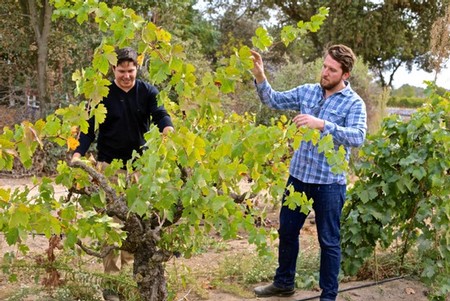
Maître de Chai's Alex Pitts (left) and Marty Winters in Clements Hills-Lodi's Stampede Vineyard
Every “new” generation re-invents the wheel. Why not?
Old-timers can recall when Robert Mondavi boldly proclaimed, in the late 1960s, that we are entering the “Golden Age of California Wine.” The 1976 “Judgement of Paris” – when a California Chardonnay and Cabernet Sauvignon happened to “best” a collection of classic French wines of similar ilk – further emboldened the Golden State wine industry, and certainly captured the attention of wine lovers across the country and around the world. It is one of many reasons why, to this day, California still produces over 66% of the wine consumed in the U.S. (re Thach MW’s Overview of the U.S. Wine Industry in 2018).
Yet cracks in this shiny façade began to appear as long ago as 1981, when New York Times wine columnist Frank Prial penned a widely circulated article blasting new fangled California wines, and even the consumers who love them. With the wordy acerbity of a mid-1960s Dylan, he wrote that California Chardonnay is an “overbred dog… too aggressive, too alcoholic… showoff wines made by vintners who seem to be saying, ‘I can outchardonnay any kid on this block.’” Of the new class of unabashed wine enthusiasts, wrote Prial, they “ape the jargon of the trade and feel special when we exchange arcane trivia about grape crushers… American wine is on the brink of becoming inbred precocious.” Not sure what that meant, but he didn’t sound too happy about it.
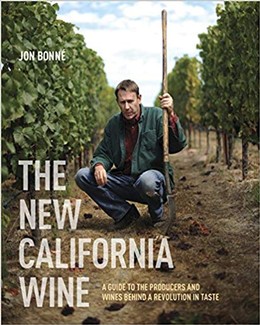
At the time, and also in retrospect, Prial’s diatribes doth protested a little too much. It’s just wine, for Pete’s sake, not a Paris Peace Accord. But guess what? A battle, of sorts, rages on. To wit, a book that popped up just five years ago by former San Francisco Chronicle wine columnist Jon Bonné, called The New California Wine (“The Guide to the Producers and Wines Behind a Revolution In Taste,” Ten Speed Press 2013) – a title that obviously implies the emergence of California wines that are more authentic than what has come before.
Bonné’s schtick? That the California wine industry has been “stuck in a self-satisfied funk.” But not to worry, because the industry is now being rescued by a new generation of small production, handcrafty, terroir focused winemakers leading all the rest, as it were, from behind. In his introduction, Bonné proclaims, with not a small amount of self-conscious profundity: “This is the best time in a generation to drink California wine. More than that, today marks the arrival of a mature wine culture, where producers are confident enough not to mimic the Old World, or obscure the nuances of terroir with 'clever' cellar work, but rather seek greatness in a uniquely American context.”
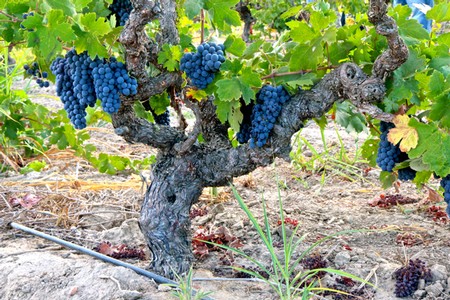
Stampede Vineyard Zinfandel during 2014 harvest
A contrarian, of course, would ask: So what does that make the products produced by the rest of the California wine industry, which everyone seems to love – chopped liver? Yet still... it’s just wine, for Pete’s sake.
No matter which amen-corner you may occupy, though, it’s encouraging to know that a number of today’s new-gen California vignerons have been finding perfectly good material to fulfill their mission in the Lodi Viticultural Area. Two of them – who are already attracting a modest following for their enthusiastic embrace of somewhat forgotten (at least by the much larger mass of wine consumers, informed by more conventional media) vineyards of genuine interest – are Marty Winters and Alex Pitts, who established their Napa-based Maître de Chai brand in 2012.
“Maître de Chai,” announces Winters and Pitts on their Web site, is the French word for the “humble cellarmaster,” and underscores their mission to “make wines of high quality in a way that best showcases the sense of place where the grapes are grown and the personality of the vineyard... from the ground to the bottle, the character of the wine is the focus of our endeavor.”
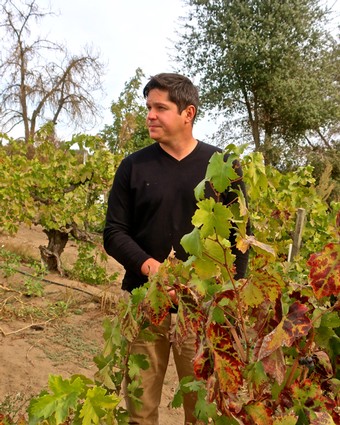
Maître de Chai co-owner/winemaker Alex Pitts in Stampede Vineyard
In late October (2018) we met up with Winters and Pitts in one of their objets de désir, the Stampede Vineyard : a block of old vine Zinfandel owned and farmed by Jeff and John Perlegos in the Clements Hills AVA of Lodi ; located on the north-westerly side of California Hwy. 88, right next to the Clements Stampede Rodeo grounds.
Says Mr. Pitts: “When Marty and I started this project, we knew Zinfandel was going to be one of our focuses. We’re big fans of Jon Bonné’s book, and we’ve become friends with many of the people the book talks about. This whetted our personal appetite for wines made from ‘strange’ grapes like Trousseau, or grapes that have become a little ‘uncool’ because of the way they’ve been handled – like Chenin blanc, Chardonnay and Sauvignon blanc. We strongly identify with California as the place where you can find historic vineyards, or vineyards that are managed the right ways, that are more likely to produce wines that are true to those sites. Zinfandel is, naturally, a key part of that story.”
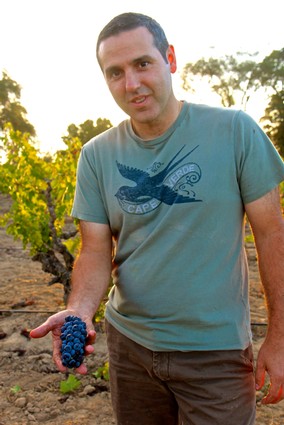
Stampede Vineyard co-owner/grower Jeff Perlegos
Adds Winters: “We first met Jeff Perlegos right here in the vineyard in 2014, through Chris Cottrell and Morgan Twain-Peterson (of Bedrock Wine Co.), and we were floored by what we saw. These are own-rooted vines – a classic, historic California planting. As far as we know, the front section of the vineyard (nearest Hwy. 88) was planted in 1928. There was an adjoining block planted in 1934, and the back-side closest to the (Mokelumne) river was planted around 1942. For our own fruit, we concentrate on vines from the oldest part of the vineyard.
“Alex and I are big on the own-rooted identity of Zinfandel, which Stampede Vineyard personifies. It produces a Zinfandel with its own unique flavor and style – higher in tannin and acid than what most people expect out of the varietal. It’s thanks to the Perlegos brothers that this vineyard, long overlooked, can now be appreciated by many more people.”
Winters elaborated, picking up a handful of ultra-fine, moon-dusty sandy soil between the Stampede Vineyard vines: “It’s the smaller clusters and berry sizes that distinguishes Stampede’s fruit – a lot of it due to the extremely fine sandy soil in this vineyard. Zinfandel is a popular varietal; and for most people, it’s a varietal associated with soft, easy jammy fruitiness rather than wines with sturdy tannin and balancing acidity. I think that’s why many serious wine lovers lost respect for the wine. Market decisions have also effected how Zinfandel is perceived by many people. Stampede Vineyard has given us the opportunity to showcase another side of the grape, while being a perfect vehicle to capture a classic sense of place.”
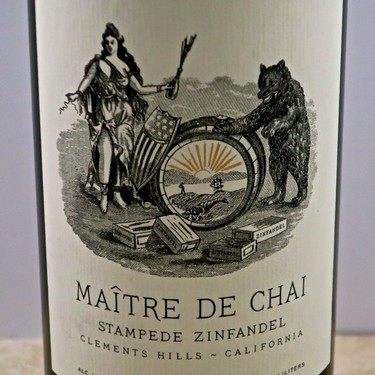
Winters and Pitts offered up two of their bottlings to illustrate their points. Their second bottling – the 2015 Maître de Chai Stampede Vineyard Clements Hills-Lodi Zinfandel ($33) – has already evolved into a seriously complex wine, steeped in ultra-bright, ringing cherry/raspberry scented fruit with baking pie spices, suggestions of loamy earthiness and tomato leaf, while remaining edgy with acidity and tannin in its medium-full bodied (14.3% alcohol) feel.
The partners’ current bottling – the 2017 Maître de Chai Stampede Vineyard Clements Hills-Lodi Zinfandel ($33) – is an even stronger iteration of their determination to produce a Zinfandel that is both true-to-place and completely different. That is to say, it is by no means “big” by conventional standards of the varietal – its 14.3% alcohol gives a compact, dense yet svelte feel. The nose suggests cherry/boysenberry pie while being tight, concentrated, with a prickly quality of youth; and muscular tannin combines with titillating acidity to sharpen the sturdily structured, almost “un-Zinfandel-like” profile.
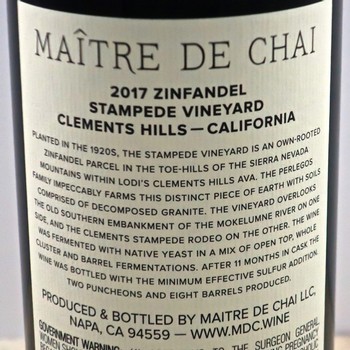
Appreciation of wine is always a matter of taste; and whether or not you appreciate the brazenly contrarian approach to Zinfandel taken by Winters and Pitts, you can still appreciate the thought process, if not the intentions.
Says Mr. Winters, “A vineyard like Stampede fulfills one of our goals of bringing attention to underappreciated grapes, vineyards and regions. It’s nice that this vineyard clearly produces more of a ‘claret’ style of Zinfandel (i.e. a strongly structured, balanced style more akin to Cabernet Sauvignon based Bordeaux reds), rather than super-ripe, full bodied style. Our role is simply bringing out the qualities that make a Stampede Zinfandel so unique, which we happen to find more appealing.
“We’re just getting started, but we’re already getting the wine placed on the wine lists of 3-star Michelin restaurants – and there aren’t too many Zinfandels, let alone from Lodi, that you can do this with. But we feel that Lodi as a region deserves that kind of respect. Lodi Zinfandels have their own incredible history. It’s not the same as Napa’s, but they have their own qualities. That’s what we want to showcase.”
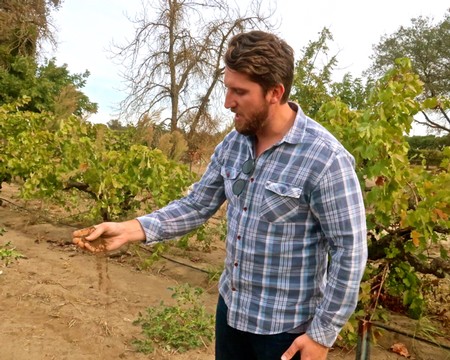
Maître de Chai co-owner/winemaker Marty Winters demonstrating the fine sandy loam in Stampede Vineyard
Pitts seconds that motion; telling us: “We’re also proud of the fact that we will pouring the MDC Stampede Zinfandel at the RAW WINE Fair in New York (which took place November 4-5, 2018) as well as at RAW WINE Los Angeles (November 11-12). These events showcase ‘natural’ wines – representing the ‘far left,’ so to speak, of the wine spectrum. We really don’t call ourselves natural wine producers, but we follow those practices to a T, since we don’t use any additives with the exception of minimal amounts of sulphur. The last thing we are trying to produce, however, is a flawed wine, and so in that respect we don’t fit in perfectly with other producers associated with the ‘natural wine’ movement.
“But we find that it’s the younger wine buyers, especially, who have an understanding of what we’re doing. People like Abe Schoener (owner of The Scholium Project) and Tegan Passalacqua (winemaker for Turley Wine Cellars and his own Sandlands Wines label) have been our biggest influencers. Abe and Tegan are proud of the fruit they get from Lodi – they’re shouting it out all over the world – and we identify with that as well. Most people still probably think of Lodi as ‘quaint,’ or something of a novelty. We think there’s something more serious going on here.”
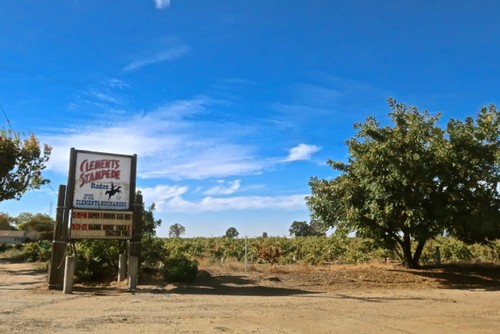
Stampede Vineyard in Lodi's Clements Hills AVA
Reflecting on their journey thus far, Winters says: “What started as a side project has become a full-time gig for us, although Alex is still working at The Scholium Project (as assistant winemaker). Sales, of course, has also become a major priority for us – besides California, our wines are now sold in New York, Texas, Utah, Louisiana, Florida, and even in Mexico City.
“Ultimately, I think the most important decision a winemaker can make is finding, and working with, a good vineyard. When a grower does the right things, you never have to resort to any tricks or manipulations as a winemaker, and the wine can be what it wants to be. You need the best vineyards for this to work, and Stampede certainly fits that criteria.”
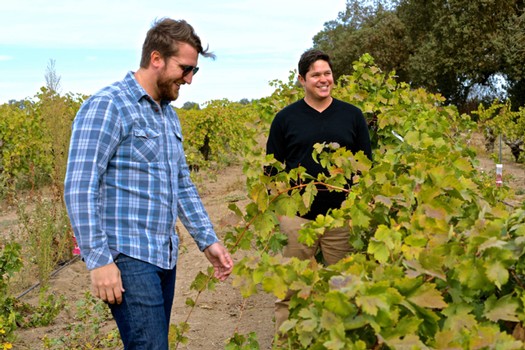
Maître de Chai co-owner/winemakers Marty Winters and Alex Pitts in Lodi's Stampede Vineyard